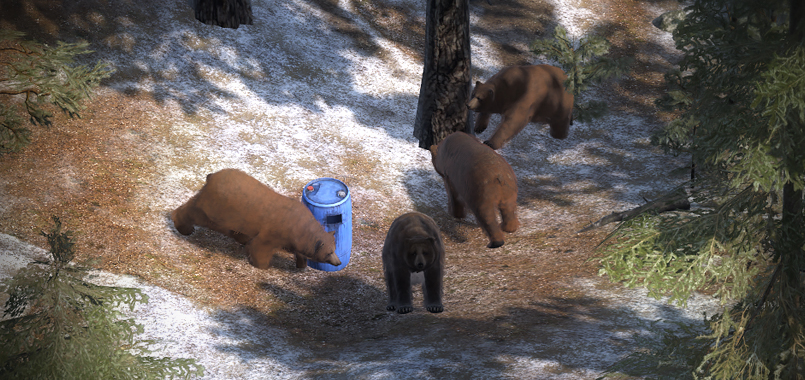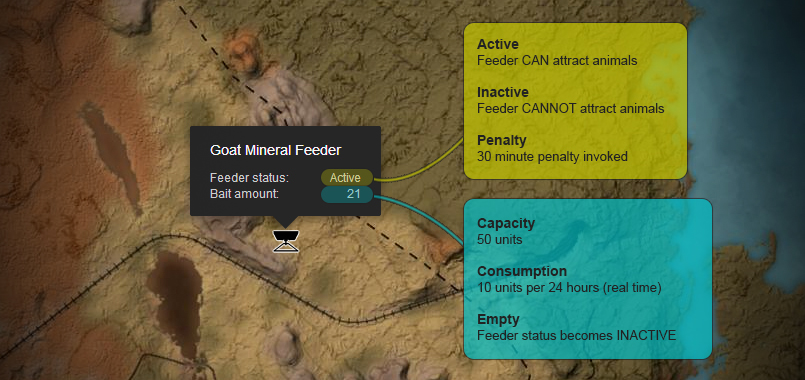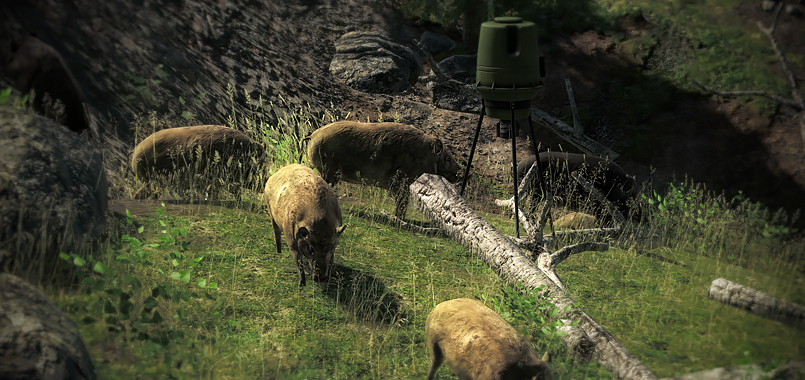Background
For quite some time many players have been reporting issues with the baiting system in theHunter, chief among the symptoms being a lack of activity at bait sites. Although not an opinion shared by everyone, it seems the general consensus among the active community is that the system was altered and “broken” at some point. Some players still enjoy acceptable and in some cases generous yields at their bait sites, while others have no such luck. This inconsistency, especially for those adversely affected, has cast a shadow over the value bait sites add to the game.
Overhaul
The good news is we have spent a great deal of time reworking the system and are pleased to introduce brand new, simplified baiting mechanics. We consulted a small panel of trusted advisors from within the community during the game design review process and we feel that the new system offers a balanced and reasonable compromise. Please read this document carefully as it contains important information about how the new baiting system works, how it compares to the old system, and what players should expect in terms of results. It is important to emphasise at this stage that the old system generated far more baited animals at bait sites than Expansive Worlds ever intended from a game balance perspective in the original game design. For that reason, players should not expect the new system to be comparable.
The “Good” Old Days
The activity at a bait site in the old system was determined by a lot of variables, most of which the player had no knowledge of, or control over. For example when a feeder was placed in a reserve, the client determined how much of the attraction zone (imagine an invisible circle around the feeder) overlapped the spawn map (imagine invisible patches on the map where species can spawn) for the species in question. The result was a figure from zero to 100, based on the percentage overlap. So if approximately 75% of the feeder overlapped the spawn map for that species, the maximum attraction level that feeder could ever reach would be 75. That is just one example, there were many other variables involved, making the system utterly complicated.
Simplify
One of the objectives when setting out to rework the baiting system was to simplify it. Not only to make the experience for the players more consistent and hopefully more enjoyable, but to make the system easier to debug, maintain, and further develop in the future. To simplify the system, some important decisions were made which have changed how baiting works now. We understand that some players may have preferred a more complex system which had a lot of unknown variables resulting in unpredictable behaviour, but it is our hope that the new system will offer better value without removing all of the challenge from baiting.
Attraction
The new system no longer has any concept of attraction, formerly a number between zero and 100. A feeder now has a status, and this can either be “active”, “inactive”, or “penalty”.
- Active: The feeder contains bait and is capable of baiting species.
- Inactive: The feeder may or may not contain bait but is incapable of baiting species.
- Penalty: The feeder is currently disabled because a baited animal was shot at the site.
When you place a new feeder in a reserve and add some bait to it, the initial status of the feeder will be inactive, for a period of 4 hours (real time). During that four hour period, the feeder will not bait any animals. After the 4 hour “warm-up” period, the status of the feeder will change to active and two things will happen; the bait will start to deplete and the feeder will be capable of baiting animals.
If you let a feeder run out of bait, the next time you add bait the 4 hour “warm-up” period will start again. This can be avoided by keeping feeders topped up with bait at all times. Topping up a feeder which already contains bait does not restart the “warm-up” period. A feeder that is kept topped up with bait will always remain active and capable of baiting animals.
If you shoot a baited animal near a feeder, a 30 minute (real time) penalty is applied to that feeder. During this time the status of the feeder will change to penalty, and the feeder will no longer bait any animals. After the 30 minute penalty period, the feeder will return to active status and will start baiting animals again. The penalty cannot be circumvented by ending the current hunt and starting a new one. In a multiplayer game, only the host can invoke the penalty by shooting a baited animal at a feeder.
Bait Consumption
This aspect of baiting has also been simplified. Bait is now consumed in a constant linear rate, whereas before it was determined by the attraction level of the feeder. The bait consumption rate is 10 units every 24 hours (real time). That means a full feeder will run out of bait exactly 5 days after being topped up.
Location, Location, Location
The location of your feeders still matters, and for that reason we have simplified this process too. Now, if you attempt to place a feeder in a location where the corresponding animal does not spawn, you will not be able to and will receive a message to this effect. This is to avoid a situation where a feeder generates no activity. This does not mean location becomes irrelevant. Some locations will still generate better results than others. This is when it becomes important to discuss locations with hunting buddies and fellow community members.
Expected Numbers
For most players an important question now will be “how many bears or hogs can I expect to see at my feeders now that the system has been overhauled?”, and the answer is, it still depends on location. The new system has been written in such a way that results should be more consistent. If you place a bear feeder in the same location as your hunting buddy, you should see pretty similar results in most hunts. There will always be variations in activity due to the random nature of the spawning system which theHunter uses, but in general results should be more predictable.
Existing Feeders
If you have an existing feeder and want to start using it again, all you have to do is add some bait. Depending on the current location, you may want to consider moving it if you feel the area is not optimal. Once you add bait to an empty feeder, remember the 4 hour “warm-up” period will start and during this phase the status of the feeder will be inactive.
If you already have feeders with bait in them, please remember that the new system is now in place and consequently, you may notice differences in the rate of bait consumption. This is particularly true if you have a feeder in a bad area which previously resulted in a low bait consumption rate. The result is a possible drop in bait in some feeders. This is not a bug and is to be expected in some cases. Unfortunately this is unavoidable but should balance out in the long run.
Technical Overview
Roberto (our lead client programmer) and I were tasked with the baiting system overhaul, and neither of us had any idea how the previous system worked, or what would be involved in beating it into shape for the new design. As is the case with many things in theHunter, it was far more complicated than it perhaps needed to be, and everyone who had ever touched the system before had either left the company, or left the team to work on other projects and probably forgot the words “baiting system” forever.
Björn Öjlert, the original game designer now working on theHunter: Call of the Wild, kindly gave us valuable feedback on how the original system was supposed to work, which helped us understand the reasoning behind some of the existing code. Needless to say though, it was still akin to wading through porridge, at least in the beginning.
The baiting system, from a technical perspective, is essentially a combination of interactions between client and backend. When you start a hunting session, the client requests information from the backend. Included in this data is information for each feeder on that reserve, including a series of timestamps (when the feeder was placed, when bait was last added, and so on), information about how much bait is in the feeder now, how much bait was in the feeder after the last fill, and more. During the hunt, any interactions with a feeder by the player (e.g. moving a feeder, placing a new feeder, filling a feeder, shooting a baited animal at a feeder) result in calls to the backend API to update the data for that feeder.
When you open the launcher and view a reserve map on which you have a feeder, a similar API call is made to the backend to obtain information for that feeder, which drives the mouse-over pop-up box containing the feeder’s status and bait level.
Final Thoughts
As with any change to a system which has been in place for a considerable amount of time, we acknowledge that these changes will evoke various reactions. Some might find the new system too simple; others might welcome the change and consistency. We endeavoured to find a compromise and we are happy with the results.
From a development point of view, we have made good progress and taken a big step forward in terms of understanding how the baiting system works. Very little of the original backend code remains, and what exists now has been optimised. We now have a solid platform upon which we can build in the future, and one which made adding the goat mineral feeders far easier than it would have been with the old system.
We can now, without any shadow of a doubt, say “the baiting system works exactly as designed”. We hope you enjoy the new system.
Share this





